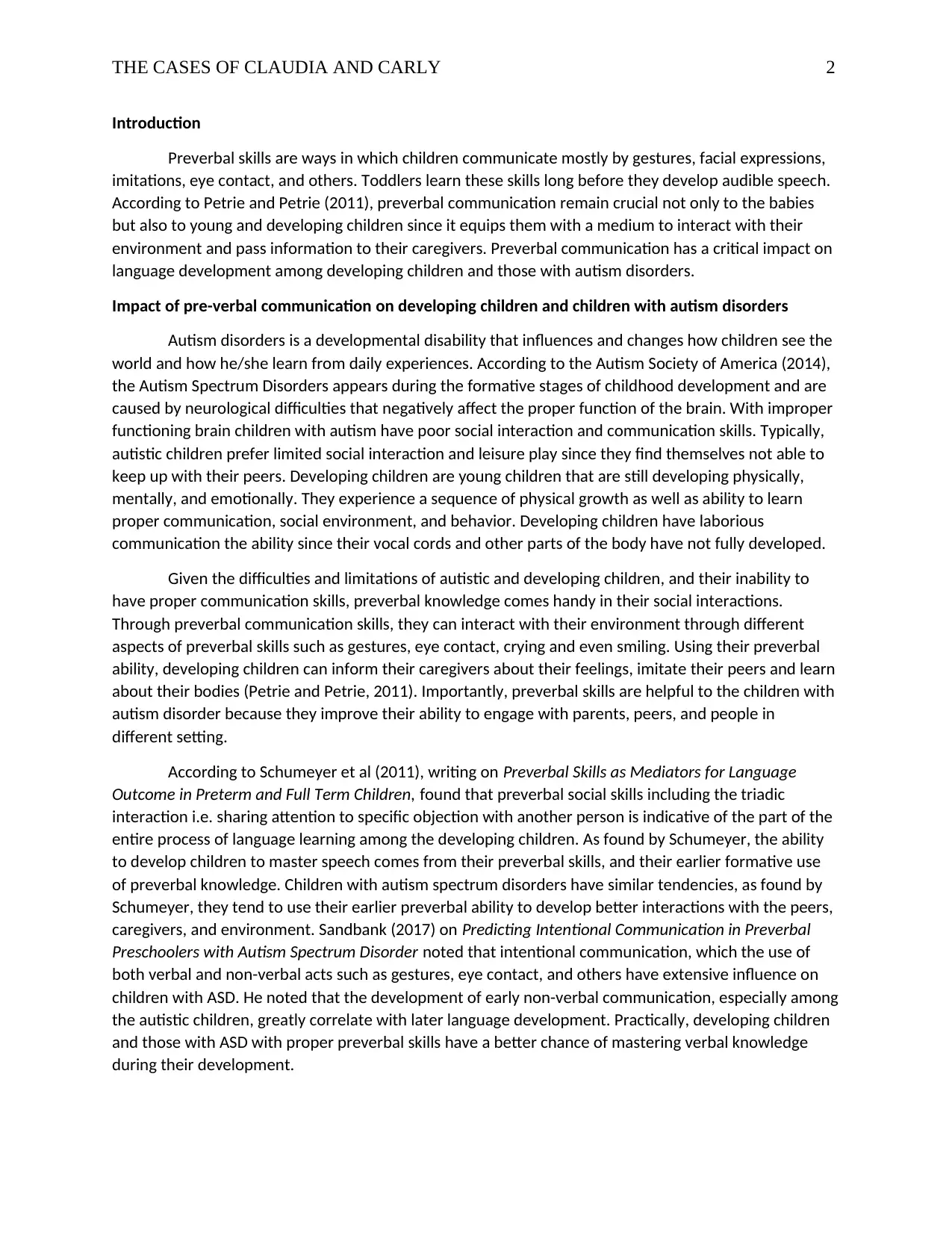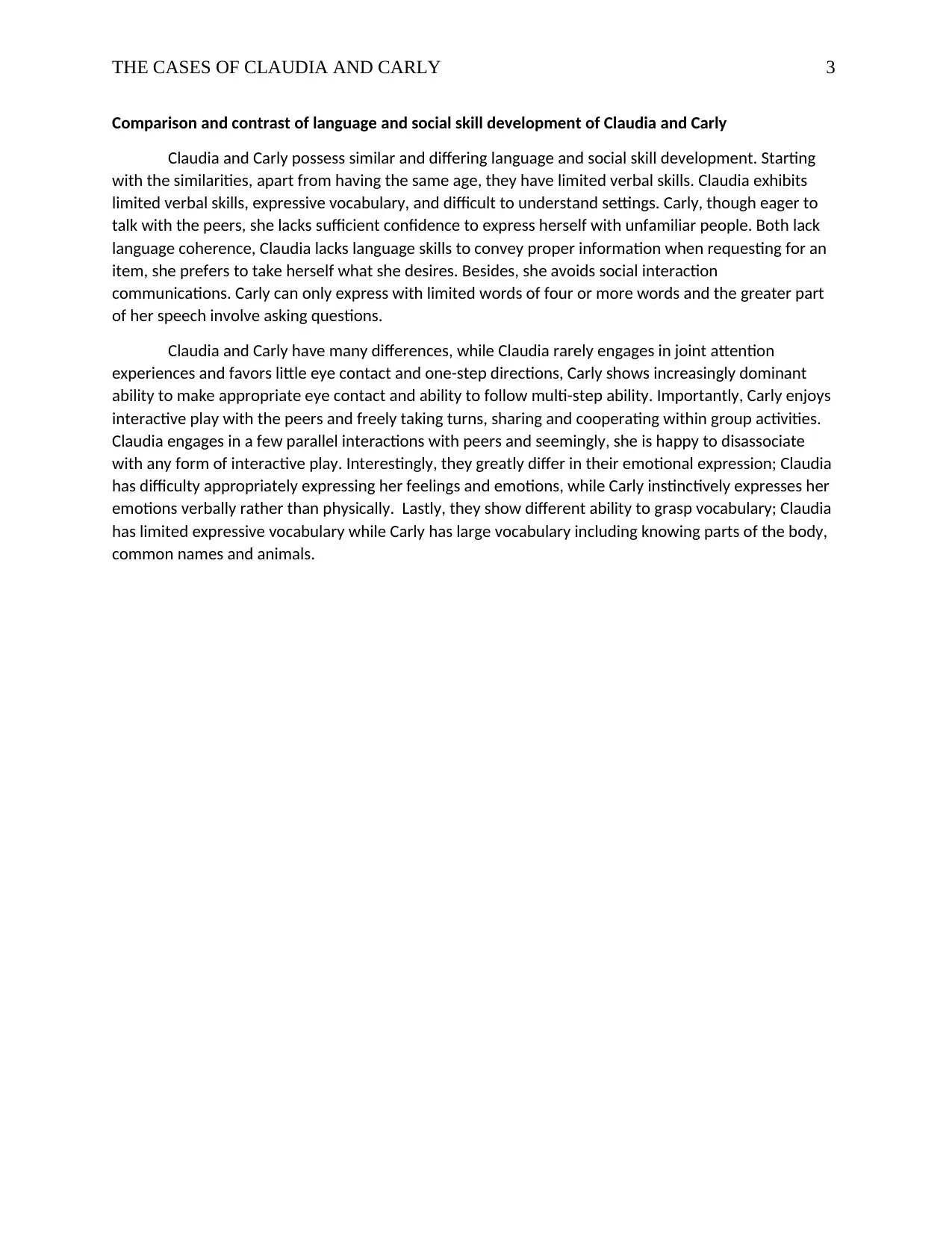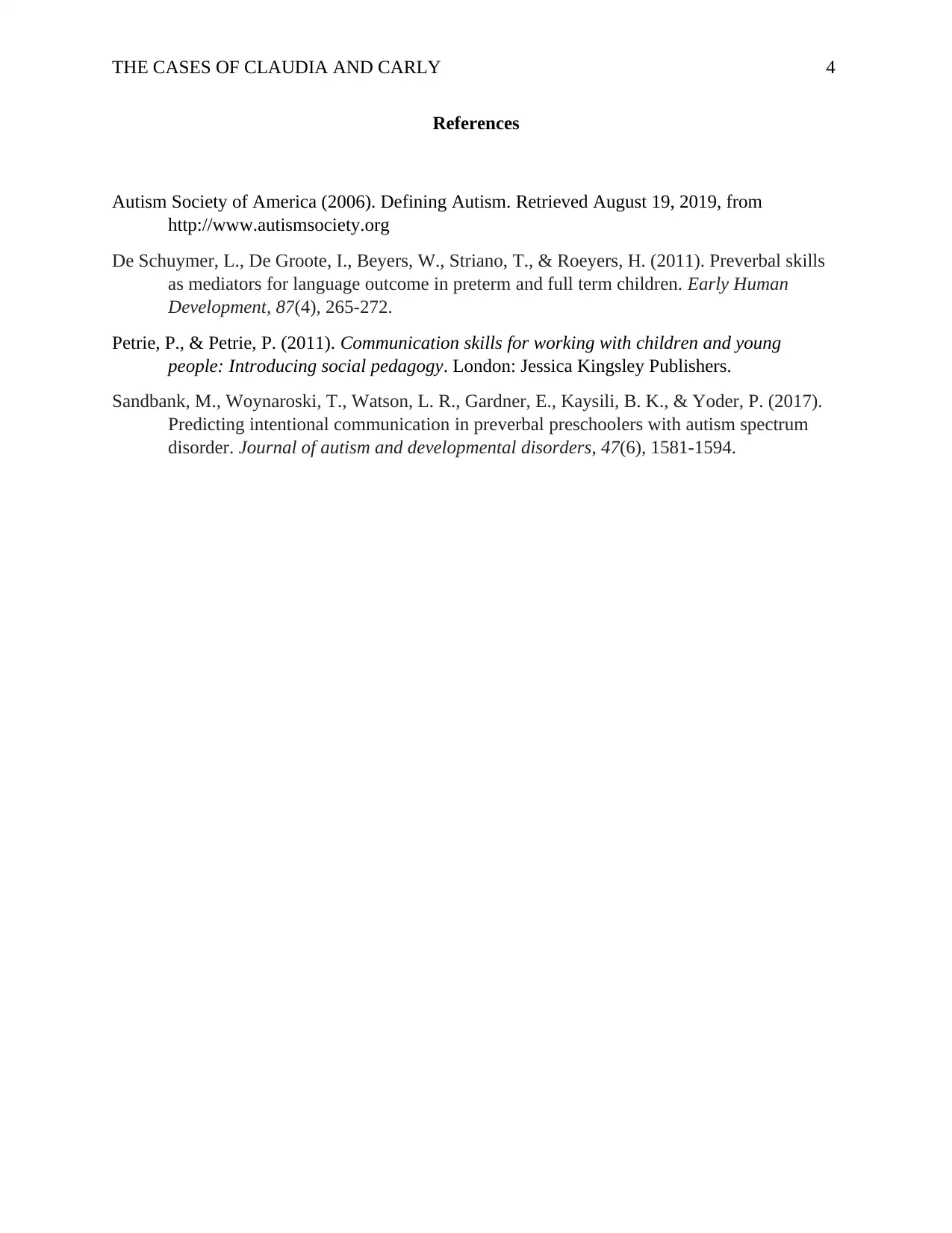CE350 - The Cases of Claudia and Carly: A Comparative Analysis
VerifiedAdded on 2022/09/18
|4
|1087
|19
Report
AI Summary
This report provides a comprehensive analysis of two case studies, Claudia and Carly, focusing on their language and social skill development. It begins with an introduction to preverbal skills, emphasizing their importance in child development, particularly for children with autism spectrum disorders (ASD). The report explores the impact of preverbal communication on both developing children and those with autism, citing research on how these skills facilitate interaction and language acquisition. A comparison and contrast of Claudia and Carly's language and social skills follows, highlighting their similarities and differences in verbal abilities, social interactions, emotional expression, and vocabulary. The report draws upon several research papers to support its arguments and provide a well-rounded analysis of the cases.

Running head: THE CASES OF CLAUDIA AND CARLY 1
The Cases of Claudia and Carly
First/Last Name
Purdue University Global
CE350 – Section #
Date
The Cases of Claudia and Carly
First/Last Name
Purdue University Global
CE350 – Section #
Date
Paraphrase This Document
Need a fresh take? Get an instant paraphrase of this document with our AI Paraphraser

THE CASES OF CLAUDIA AND CARLY 2
Introduction
Preverbal skills are ways in which children communicate mostly by gestures, facial expressions,
imitations, eye contact, and others. Toddlers learn these skills long before they develop audible speech.
According to Petrie and Petrie (2011), preverbal communication remain crucial not only to the babies
but also to young and developing children since it equips them with a medium to interact with their
environment and pass information to their caregivers. Preverbal communication has a critical impact on
language development among developing children and those with autism disorders.
Impact of pre-verbal communication on developing children and children with autism disorders
Autism disorders is a developmental disability that influences and changes how children see the
world and how he/she learn from daily experiences. According to the Autism Society of America (2014),
the Autism Spectrum Disorders appears during the formative stages of childhood development and are
caused by neurological difficulties that negatively affect the proper function of the brain. With improper
functioning brain children with autism have poor social interaction and communication skills. Typically,
autistic children prefer limited social interaction and leisure play since they find themselves not able to
keep up with their peers. Developing children are young children that are still developing physically,
mentally, and emotionally. They experience a sequence of physical growth as well as ability to learn
proper communication, social environment, and behavior. Developing children have laborious
communication the ability since their vocal cords and other parts of the body have not fully developed.
Given the difficulties and limitations of autistic and developing children, and their inability to
have proper communication skills, preverbal knowledge comes handy in their social interactions.
Through preverbal communication skills, they can interact with their environment through different
aspects of preverbal skills such as gestures, eye contact, crying and even smiling. Using their preverbal
ability, developing children can inform their caregivers about their feelings, imitate their peers and learn
about their bodies (Petrie and Petrie, 2011). Importantly, preverbal skills are helpful to the children with
autism disorder because they improve their ability to engage with parents, peers, and people in
different setting.
According to Schumeyer et al (2011), writing on Preverbal Skills as Mediators for Language
Outcome in Preterm and Full Term Children, found that preverbal social skills including the triadic
interaction i.e. sharing attention to specific objection with another person is indicative of the part of the
entire process of language learning among the developing children. As found by Schumeyer, the ability
to develop children to master speech comes from their preverbal skills, and their earlier formative use
of preverbal knowledge. Children with autism spectrum disorders have similar tendencies, as found by
Schumeyer, they tend to use their earlier preverbal ability to develop better interactions with the peers,
caregivers, and environment. Sandbank (2017) on Predicting Intentional Communication in Preverbal
Preschoolers with Autism Spectrum Disorder noted that intentional communication, which the use of
both verbal and non-verbal acts such as gestures, eye contact, and others have extensive influence on
children with ASD. He noted that the development of early non-verbal communication, especially among
the autistic children, greatly correlate with later language development. Practically, developing children
and those with ASD with proper preverbal skills have a better chance of mastering verbal knowledge
during their development.
Introduction
Preverbal skills are ways in which children communicate mostly by gestures, facial expressions,
imitations, eye contact, and others. Toddlers learn these skills long before they develop audible speech.
According to Petrie and Petrie (2011), preverbal communication remain crucial not only to the babies
but also to young and developing children since it equips them with a medium to interact with their
environment and pass information to their caregivers. Preverbal communication has a critical impact on
language development among developing children and those with autism disorders.
Impact of pre-verbal communication on developing children and children with autism disorders
Autism disorders is a developmental disability that influences and changes how children see the
world and how he/she learn from daily experiences. According to the Autism Society of America (2014),
the Autism Spectrum Disorders appears during the formative stages of childhood development and are
caused by neurological difficulties that negatively affect the proper function of the brain. With improper
functioning brain children with autism have poor social interaction and communication skills. Typically,
autistic children prefer limited social interaction and leisure play since they find themselves not able to
keep up with their peers. Developing children are young children that are still developing physically,
mentally, and emotionally. They experience a sequence of physical growth as well as ability to learn
proper communication, social environment, and behavior. Developing children have laborious
communication the ability since their vocal cords and other parts of the body have not fully developed.
Given the difficulties and limitations of autistic and developing children, and their inability to
have proper communication skills, preverbal knowledge comes handy in their social interactions.
Through preverbal communication skills, they can interact with their environment through different
aspects of preverbal skills such as gestures, eye contact, crying and even smiling. Using their preverbal
ability, developing children can inform their caregivers about their feelings, imitate their peers and learn
about their bodies (Petrie and Petrie, 2011). Importantly, preverbal skills are helpful to the children with
autism disorder because they improve their ability to engage with parents, peers, and people in
different setting.
According to Schumeyer et al (2011), writing on Preverbal Skills as Mediators for Language
Outcome in Preterm and Full Term Children, found that preverbal social skills including the triadic
interaction i.e. sharing attention to specific objection with another person is indicative of the part of the
entire process of language learning among the developing children. As found by Schumeyer, the ability
to develop children to master speech comes from their preverbal skills, and their earlier formative use
of preverbal knowledge. Children with autism spectrum disorders have similar tendencies, as found by
Schumeyer, they tend to use their earlier preverbal ability to develop better interactions with the peers,
caregivers, and environment. Sandbank (2017) on Predicting Intentional Communication in Preverbal
Preschoolers with Autism Spectrum Disorder noted that intentional communication, which the use of
both verbal and non-verbal acts such as gestures, eye contact, and others have extensive influence on
children with ASD. He noted that the development of early non-verbal communication, especially among
the autistic children, greatly correlate with later language development. Practically, developing children
and those with ASD with proper preverbal skills have a better chance of mastering verbal knowledge
during their development.

THE CASES OF CLAUDIA AND CARLY 3
Comparison and contrast of language and social skill development of Claudia and Carly
Claudia and Carly possess similar and differing language and social skill development. Starting
with the similarities, apart from having the same age, they have limited verbal skills. Claudia exhibits
limited verbal skills, expressive vocabulary, and difficult to understand settings. Carly, though eager to
talk with the peers, she lacks sufficient confidence to express herself with unfamiliar people. Both lack
language coherence, Claudia lacks language skills to convey proper information when requesting for an
item, she prefers to take herself what she desires. Besides, she avoids social interaction
communications. Carly can only express with limited words of four or more words and the greater part
of her speech involve asking questions.
Claudia and Carly have many differences, while Claudia rarely engages in joint attention
experiences and favors little eye contact and one-step directions, Carly shows increasingly dominant
ability to make appropriate eye contact and ability to follow multi-step ability. Importantly, Carly enjoys
interactive play with the peers and freely taking turns, sharing and cooperating within group activities.
Claudia engages in a few parallel interactions with peers and seemingly, she is happy to disassociate
with any form of interactive play. Interestingly, they greatly differ in their emotional expression; Claudia
has difficulty appropriately expressing her feelings and emotions, while Carly instinctively expresses her
emotions verbally rather than physically. Lastly, they show different ability to grasp vocabulary; Claudia
has limited expressive vocabulary while Carly has large vocabulary including knowing parts of the body,
common names and animals.
Comparison and contrast of language and social skill development of Claudia and Carly
Claudia and Carly possess similar and differing language and social skill development. Starting
with the similarities, apart from having the same age, they have limited verbal skills. Claudia exhibits
limited verbal skills, expressive vocabulary, and difficult to understand settings. Carly, though eager to
talk with the peers, she lacks sufficient confidence to express herself with unfamiliar people. Both lack
language coherence, Claudia lacks language skills to convey proper information when requesting for an
item, she prefers to take herself what she desires. Besides, she avoids social interaction
communications. Carly can only express with limited words of four or more words and the greater part
of her speech involve asking questions.
Claudia and Carly have many differences, while Claudia rarely engages in joint attention
experiences and favors little eye contact and one-step directions, Carly shows increasingly dominant
ability to make appropriate eye contact and ability to follow multi-step ability. Importantly, Carly enjoys
interactive play with the peers and freely taking turns, sharing and cooperating within group activities.
Claudia engages in a few parallel interactions with peers and seemingly, she is happy to disassociate
with any form of interactive play. Interestingly, they greatly differ in their emotional expression; Claudia
has difficulty appropriately expressing her feelings and emotions, while Carly instinctively expresses her
emotions verbally rather than physically. Lastly, they show different ability to grasp vocabulary; Claudia
has limited expressive vocabulary while Carly has large vocabulary including knowing parts of the body,
common names and animals.
⊘ This is a preview!⊘
Do you want full access?
Subscribe today to unlock all pages.

Trusted by 1+ million students worldwide

THE CASES OF CLAUDIA AND CARLY 4
References
Autism Society of America (2006). Defining Autism. Retrieved August 19, 2019, from
http://www.autismsociety.org
De Schuymer, L., De Groote, I., Beyers, W., Striano, T., & Roeyers, H. (2011). Preverbal skills
as mediators for language outcome in preterm and full term children. Early Human
Development, 87(4), 265-272.
Petrie, P., & Petrie, P. (2011). Communication skills for working with children and young
people: Introducing social pedagogy. London: Jessica Kingsley Publishers.
Sandbank, M., Woynaroski, T., Watson, L. R., Gardner, E., Kaysili, B. K., & Yoder, P. (2017).
Predicting intentional communication in preverbal preschoolers with autism spectrum
disorder. Journal of autism and developmental disorders, 47(6), 1581-1594.
References
Autism Society of America (2006). Defining Autism. Retrieved August 19, 2019, from
http://www.autismsociety.org
De Schuymer, L., De Groote, I., Beyers, W., Striano, T., & Roeyers, H. (2011). Preverbal skills
as mediators for language outcome in preterm and full term children. Early Human
Development, 87(4), 265-272.
Petrie, P., & Petrie, P. (2011). Communication skills for working with children and young
people: Introducing social pedagogy. London: Jessica Kingsley Publishers.
Sandbank, M., Woynaroski, T., Watson, L. R., Gardner, E., Kaysili, B. K., & Yoder, P. (2017).
Predicting intentional communication in preverbal preschoolers with autism spectrum
disorder. Journal of autism and developmental disorders, 47(6), 1581-1594.
1 out of 4
Related Documents
Your All-in-One AI-Powered Toolkit for Academic Success.
+13062052269
info@desklib.com
Available 24*7 on WhatsApp / Email
![[object Object]](/_next/static/media/star-bottom.7253800d.svg)
Unlock your academic potential
Copyright © 2020–2025 A2Z Services. All Rights Reserved. Developed and managed by ZUCOL.





